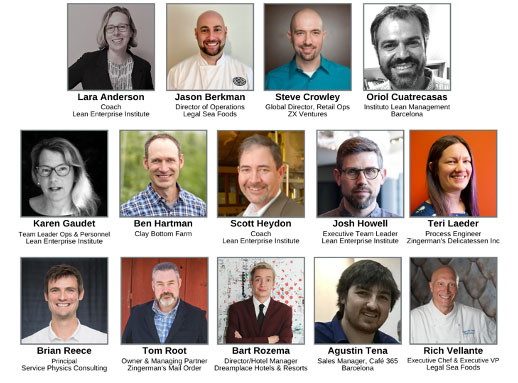As the world comes to terms with the devastating impact of Covid-19 on the global economy, it is clear that no sector will be spared. For one industry, in particular, the threat posed by this pandemic is existential.
After weeks of lockdown, restaurants and cafes have been plunged into uncertainty. The overwhelming majority of them are currently closed and it’s likely that many will never re-open. The lifting of lockdowns, which has already begun in a number of countries, won’t solve their problems: with strict safety measures (like social distancing) likely to remain in force for the foreseeable future, staying afloat will represent a monumental challenge for most of these organizations.
Those businesses that have been able to quickly pivot – perhaps by reinventing themselves as take-out restaurants – are operating every day with very concrete problems they never imagined they’d experience, whereas others are just longing for the day when they have the opportunity to reopen. Whether you are fighting problems right now or anticipating what these problems will be, we believe this article can help you.
For the past few weeks, lean organizations around the world – from manufacturing companies to hospitals – have demonstrated an extraordinary ability to adapt (just read the story of Ben Hartman, the lean farmer). They have done so by observing and studying the “new normal” right at the front line and engaging all members of staff in scientific problem solving. If you work in the restaurant business and are reading this you might not know what we are talking about. Indeed, Lean Thinking is still fairly unknown in your world. For the past three decades, however, this alternative management approach has transformed thousands of organizations forever, helping them to leverage the talent and capabilities of their people to improve continuously, solve problems creatively and create a sustainable business model.
What is lean and where do you start?
Every restaurant (indeed, every organization) is unique and we understand that any approach to improving things or solving problems needs to take that uniqueness into account. What makes Lean Thinking so revolutionary is that it doesn’t provide you with the solutions to your problems, but with the tools you need to discover those solutions on your own.
It is with this spirit that we have prepared this document. It taps into the collective experience and knowledge of our team (which includes some of the pioneering organizations that were among the first in the food industry to embrace Lean Thinking and the coaches who supported their transformations) to offer you a set of practical tips that restaurants around the world can follow to maximize their chances of a safe and successful reopening. We are not prescribing a set of guidelines, but encouraging you to imagine how these practices and principles can apply to your circumstances.
Beyond the acute phase of the emergency and its immediate aftermath, we believe the food industry is at a turning point. This is the time to reimagine your business, redesign your future and leave your wasteful ways behind. Lean Thinking can help you do just that.
The five core ideas around which we are organizing our set of recommendations are:
- Understanding what constitutes value for the customer, something that is sure to have changed dramatically with Covid-19.
- Designing the flow of the work to deliver that value to your customer as quickly and as safely as possible.
- Relying on standardized work to ensure safety for customers and employees.
- Fostering the creation of a problem-solving culture that puts the individual at the heart of the improvement activity.
- Removing waste to minimize costs, which is deliberately placed last. Lean thinkers believe that it is by providing value to customers and caring for your staff that you can achieve financial success.
1. Clarify new customer needs and desires, and keep adjusting as the situation unfolds
- Ask yourself what creates value for your customers in these uncertain times. How have their expectations changed?
- Offer new products/services that respond to new customer problems. (Some of your products may not change, but others will certainly require modification.)
- To feel comfortable eating out, customers will need to unmistakably see that cleanliness and hygiene are top priorities in your establishment. Clearly communicate protocols and standards and demonstrate that customer safety is paramount. You may ask yourself, “How can this be communicated non verbally?” The use of visual signals can prevent the need for close contact.
- Help customers in their transition back to “normal” life. Reflect on how your team can create a more hospitable environment and, if needed, address awkward consumer experiences.
- Identify new sales channels (like take-out or delivery) and adjust your marketing efforts accordingly.
Example 1 – ZINGERMAN’S COMMUNITY OF BUSINESSES
The Zingerman’s Community of Businesses has three catering companies. For them, pivoting and adjusting to new customer needs meant to start providing meal replacement. Customers can now pick up a kit, take it home and either reheat it or add some ingredients to complete preparation. Similarly, when the company’s Farmers Market was closed, they began reaching out to farms to include bread, cheese and coffee into CSAs to provide customers with a more well-rounded offer.
Example 2 – CLAY BOTTOM FARM
Ben Hartman’s lean farm always starts with the customer and works backwards, asking themselves three key questions: What do customers want? When do they want it? How much of it do they want? In the current situation, priorities changed but talking to customers has allowed Ben to pivot in just one week. “Your job is to discover what customers now value and restructure your food service around those value attributes,” he says.
2. Design flow for customers, workers, and the food & drinks based on the new value-proposition
- Carry out an analysis of the customer flow to remove any interruptions and keep it safe at all times. Draw the layout of your establishment and the pathways of workers and customers through that layout: this will allow you to identify the risks to maintaining physical distance between people, both customers and employees.
- Keep people moving. This will reduce the lead-time, but also the customer’s exposure to potential infection.
- Make adjustments to the store layout to accommodate the needs of social distancing and reduced in-store dining traffic. (For instance, restaurants could stop accepting walk-ins and take reservations only.)
- Ensure the guest journey in the environment is clear, by building visual cues and physical barriers so that enforcement by staff is not necessary.
- Determine how to level the load of customers throughout the day. (For instance, you may choose to implement flexible opening hours).
- Make all hand-offs “contactless”: this applies to deliveries, takeout pick-ups and table side delivery for restaurants with open dining rooms.
Example 1 – CAFÉ 365, BARCELONA
At the company’s cafes in Barcelona, in preparation for reopening, visual management on the floor indicates the flow of guests through the store and reminds them of the need to maintain social distancing at all times.
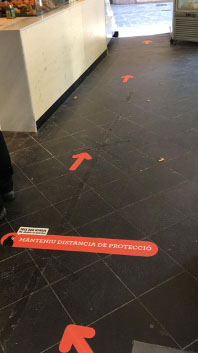
Example 2 – ZINGERMAN’S COMMUNITY OF BUSINESSES
Zingerman’s Roadhouse closed its doors to dine-in customers on March 16th and quickly pivoted to take-out only, leveraging its drive-through area. The dining area was turned into a To Go process assembly line and 5S [a set of workplace organization practices consisting of Sorting, Setting in order, Shining, Standardizing, Sustaining] was used to streamline operations, by removing unnecessary items and introducing new standards for cleanliness and hygiene. To keep social distancing requirements, most of the To Go fulfillment process moved into the dining room. They created flow and allowed the swell of capacity to be met by utilizing the now empty seating areas. Orders are staged by having the kitchen staff put the items in the bins; a second fulfillment staff member then packs the items from the bin into bags or delivery pouches; totes slide left to right for fulfillment, keeping flow towards the guests waiting in cars.

Example 3 – DREAMPLACE HOTELS, TENERIFE
The hotel is using the “break” to rethink its system and flows and to run those experiments that they could not have carried out with the hotel running. They are currently experimenting with spaghetti charting (an exercise consisting of tracing lines that map the movement of people through space as they work or serve customers) to determine how to manage the flow of their 750 guests to ensure everyone is getting the experience they are looking for, while maintaining 1.5-meter personal distance. In the images below, we can see – respectively – the required adjustments to one of the dining rooms of a Dreamplace hotel, the proposed floor plan post-Covid, and an example of spaghetti chart.
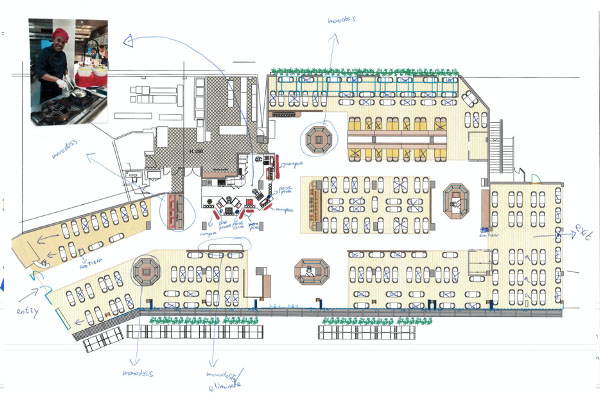
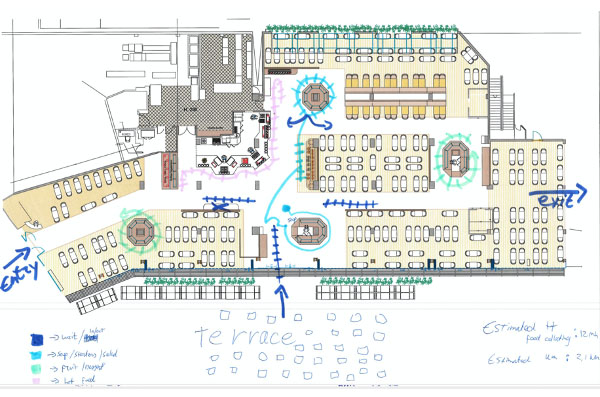
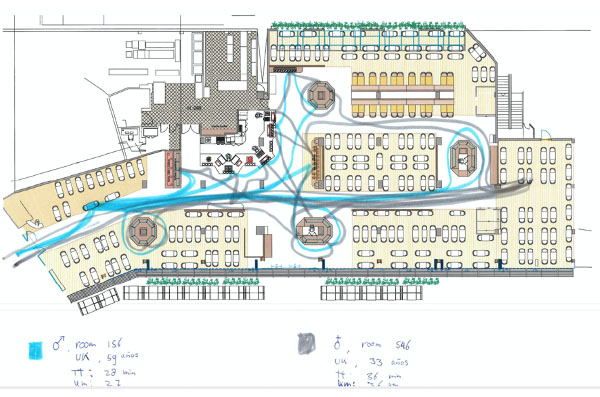
Example 4 – LEGAL SEA FOODS
In the picture below, you can see the spaghetti chart mapping the movement of a server getting pie served onto plates before the process was streamlined. This tool is often an eye-opener, highlighting many opportunities for improvement.
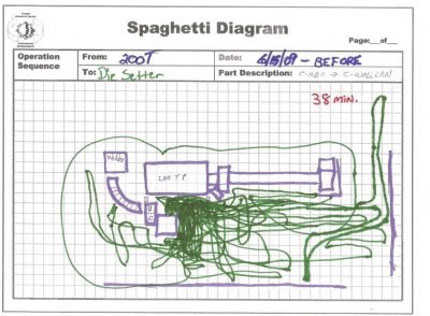
3. Keep everyone safe, physically and psychologically, through standard work and simple visual cues.
- Never forget about staff safety, both physical and psychological. Without it, there won’t be safety for customers either.
- To win the hearts and minds of employees, leaders must exhibit care, resiliency, empathy, agility and a clear message of purposeful work to strengthen employee trust and engagement.
Design every job or task – done by a worker, manager or customer – with safety in mind.
- Training should be provided with the entire customer and worker experience in mind. For the process to work, teamwork and an understanding of the big picture are necessary. Ideally, provide training without having to do so in person.
- Establish high-frequency, small-batch cycles for sanitizing high-touch surfaces, especially where hand-offs occur. Have clear sanitation practices in place for cleaning, social distancing protocol, break scheduling and hygiene standards (mask wearing, hand-washing every time the food contact chain is broken, closed drink cups, etc).
- Keep standards simple and easy to remember and rely on visual controls at the point of use to make them second nature. Always document them (to help staff who is unfamiliar with a task pick it up quickly) and keep them updated.
- Make your menu strategy and payments contactless whenever possible, to limit the risk of fomite infection (object to human).
- Limit unnecessary worker movement that increases the risk of physical distancing violations (for example, you might consider storing all necessary supplies at the point of use whenever possible).
- Use visual controls to help customers do the right thing and play their role in keeping everyone safe.
</li
Example 1 – CAFÉ 365, BARCELONA
In this photo, you can see the window of a 365 café in Barcelona displaying a message saying, “You are all heroes. Don’t let your guard down” – accompanied by visual cues explaining the safety measures that customers must follow. This is a way to empower customers to do their part.
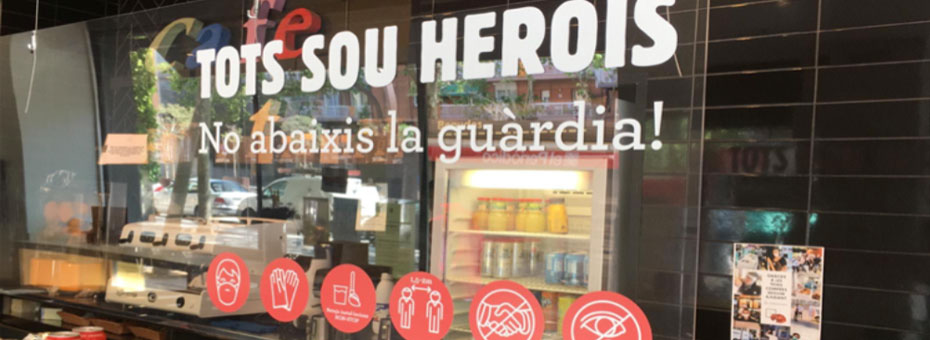
Example 2 – ZINGERMAN’S COMMUNITY OF BUSINESSES
The company typically operates with 700+ employees. In the first weeks of restaurant closures, they had to furlough more than half of their staff. To ensure that half of their institutional knowledge would not be walking out the door with them, they had to make sure that processes were clearly documented. In the areas where they had not had the foresight to do so, it became clear that standards had to be set quickly and taught during the cross-training to give new staff the tools to be successful in new areas.
Example 3 – LEGAL SEA FOODS
This is a Job Breakdown Sheet developed in a Legal Sea Foods restaurant to ensure proper and effective training of new work procedures and to ensure these are clearly understood. This approach also enables problem solving around the work routine itself.
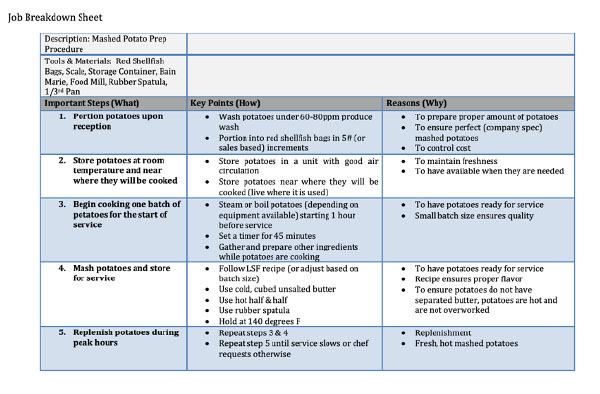
Example 4 – ZINGERMAN’S
Below, from the left, you can see the Covid-19 screening station for staff installed at the Zingerman’s Creamery, inside the staff-only entrance; a sign at the staff entrance; distancing markers outside of Zingerman’s Bakehouse for guests to wait due to capacity constraints on the interior retail area; the kick plate guests can use to enter the Bakehouse instead of touching a door handle.

Example 5 – DELRIDGE GROCERY CO-OP
Having to open up in the middle of the pandemic, this co-op in Seattle had to find a way to make its employees and customers feel safe. For customers, they began to reserve 15-minute pick-up windows for online orders, with pick-up taking place on the sidewalk outside the retail space or on the curbside directly into the vehicle. Visual management on the sidewalk is used to keep people at least 6 feet apart. The team relied heavily on it in the retail space, too, to ensure the safety of volunteers.
4. Build frequent problem solving, learning and improvement into everyone’s job.
- Be available and visit workers frequently, to show respect and support them in problem solving. This will speed up changes and make your business more flexible. Problem solving happens at the place of work, not in a corporate office.
- Use visual management to distinguish normal/abnormal work, and to understand if you are ahead or behind.
- Identify a task force dedicated to adjusting safety measures, protocols and policies as they evolve (and when new problems arise) and ensuring changes are known and used by all.
- Listen to front-line staff and ask them to suggest improvements. Ensure communication (both internal and external) is transparent and set clear expectations.
- Ultimately, a sustainable operating model must be identified and implemented. If your business is still closed, use the time to reflect, review processes and think about what you want your business to look like in the future. Review your strategy and devise a new plan to execute it.
Example 1 – ZX VENTURES
Steve Crowley, Global Director of Retail Operations, said: “This crisis started for us in January, because we service Asia as well. We started shutting down locations during the preparation for Chinese New Year and just didn’t reopen them. We have now been open in China for several weeks and we’re starting to see business come back. At first, we opened with delivery and had almost zero delivery capability. As I reflect on this experience, it’s clear that rather than focusing on specifically addressing things within the operation of the four walls, what served us best was having a methodology around problem solving.”
Example 2 – DREAMPLACE HOTELS
The Tigotan Hotel in Tenerife is expecting to incorporate a new set of KPIs into its strategy deployment (hoshin kanri), including the number of cancellations due to Covid-19, the number of complaints due to safety measures being too strict/too loose, and the number of workdays missed due to coronavirus-related issues. Reflecting the “new normal”, once the hotels reopen, front-line workers (who traditionally work in small teams of 6-7 people and meet once a week for a 30-minute meeting they use to discuss problems and coordinate) will actively work on the continuous improvement of safety measures. Bart Rozema, Hotel Manager, says: “They have been doing kaizen [improvement] and problem solving for a few years now, so we’ll just have to shift their focus towards using their collective experience, knowledge and intelligence to improve our anti-Covid measures, for both staff and guests.”
Example 3
As leaders are removed from the front line work trying to make the best decisions, it is important to understand the impact of these decisions on the front line team and on customers. For example, if it is decided that surfaces must be sanitized more frequently, the leader must involve those who will be doing that work to understand “how” they will be able to incorporate the additional work steps. If the work to clear a table takes 3 minute and that work is now going to include the replenishment of hand sanitizer provided to guests, the time it takes to perform that task must be considered. Ask yourself questions like, “Where is the sanitizer kept?” or “How will the other team members and guests visually know that the area has been sanitized and replenished?”.
5. Minimize costs.
- Look for waste across your organization to enable front-line workers to make quality and safety decisions. This includes rethinking workspace, layout, delivery systems and hours of operation.
- Ask yourself how labor and production can meet demand with minimal to zero left over. How can we improve our inventory turn times (how fast items are sold versus sitting on the shelf)? What influences inventory build-up? How can we meet demand in real-time?
- Limit menu and drink offerings to reduce the complexity in the work. Give customers what they want: in the age of Covid-19, it’s likely that they will care more about ease of ordering, quick service, and cleanliness than they do about having an endless range of menu options.
- Prepare for a possible quick pivot if your business is to survive. Delivery seems to be an obvious opportunity for restaurants and cafes, but it comes with its own challenges (little marketing capability for the new “format” of your business and more fixed costs for commissions, fees, etc).
Example 1
As business tries to re-open and rebuild demand, balancing the amount of needed labor with the capacity necessary to grow demand and ramp up to profitability or break even is likely to be a challenge. Understanding the time it takes to perform the work of preparing, assembling and serving the food, with all of the required food safety and cleanliness measures in place, can help inform the number of people you need. During the Newtown crisis, the local Starbucks stores were able to adjust to the extreme variations in demand because they were able to understand, based on the arrival rate of the customers and the time it took to prepare and deliver beverages and food, how many people were needed to do the work. They then were able to gauge how to staff to support the community conversations that were needed to be emotionally present for the customers.
Example 2 – LEGAL SEA FOODS
The team researched the actual consumption of cut fruit – lime, lemons, cucumber, etc – by guests in a worst-case scenario (peak consumption over the course of a year) and then measured how much was prepared daily. They discovered there was a lot of “overproduction”: too much fruit was being cut. Then they set daily “fill up” quantities to prepare, minus whatever was left over from a previous shift. The picture below shows the dramatic reduction of waste achieved.
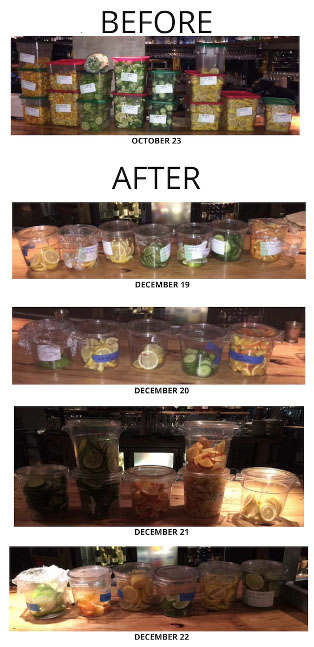
Example 3 – CAFÉ 365, BARCELONA
In this video, the CEO of Cafe.365 – Juan Antonio Tena – explains how Lean Thinking fueled the growth of the business, by teaching them to do more with less resources. Continuously removing waste from the process, thinking creatively about the work, consistently developing people’s problem-solving capabilities and always trying to delight the customers has guaranteed the success and the expansion of this business from a handful of stores to a regional chain.
The Authors
